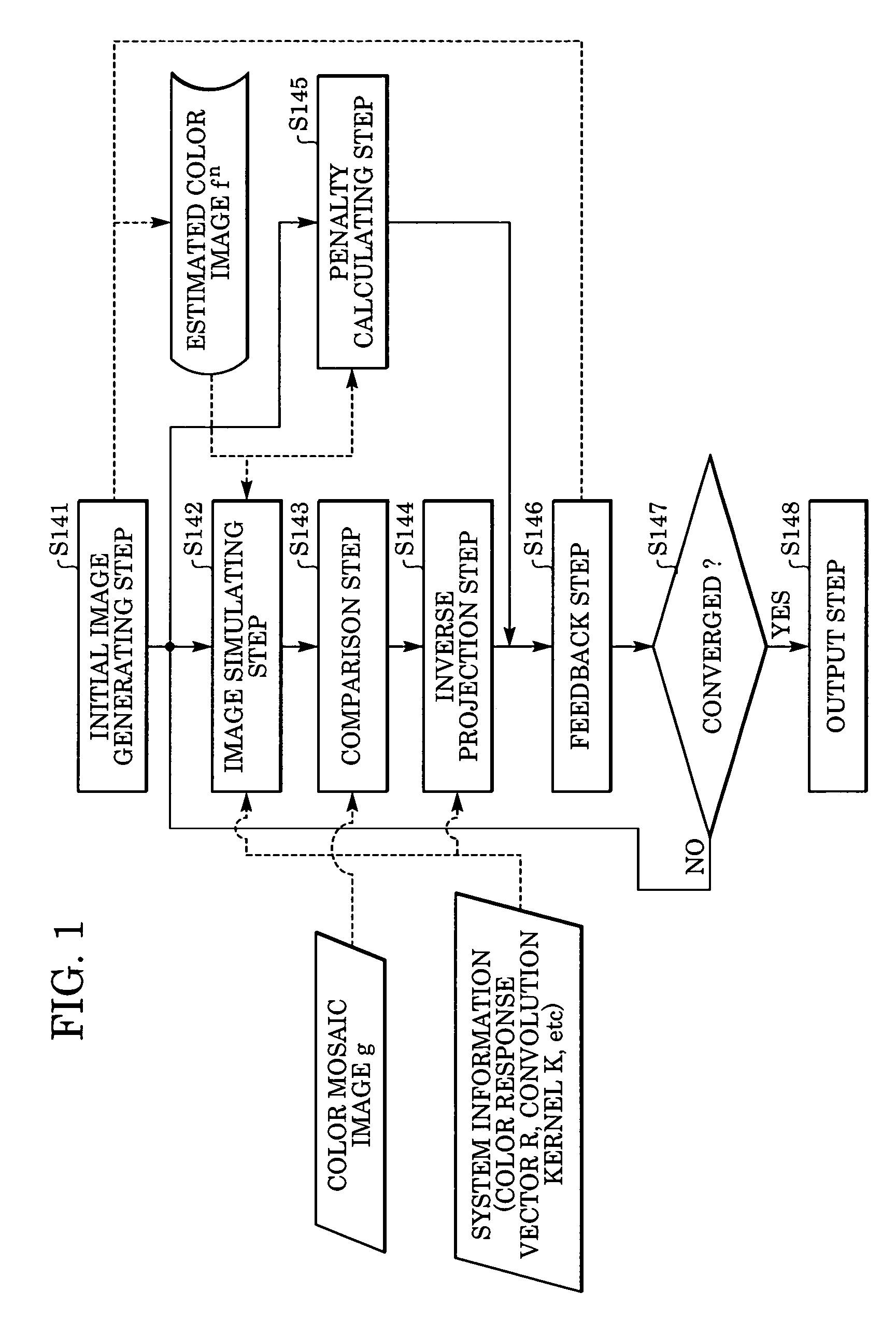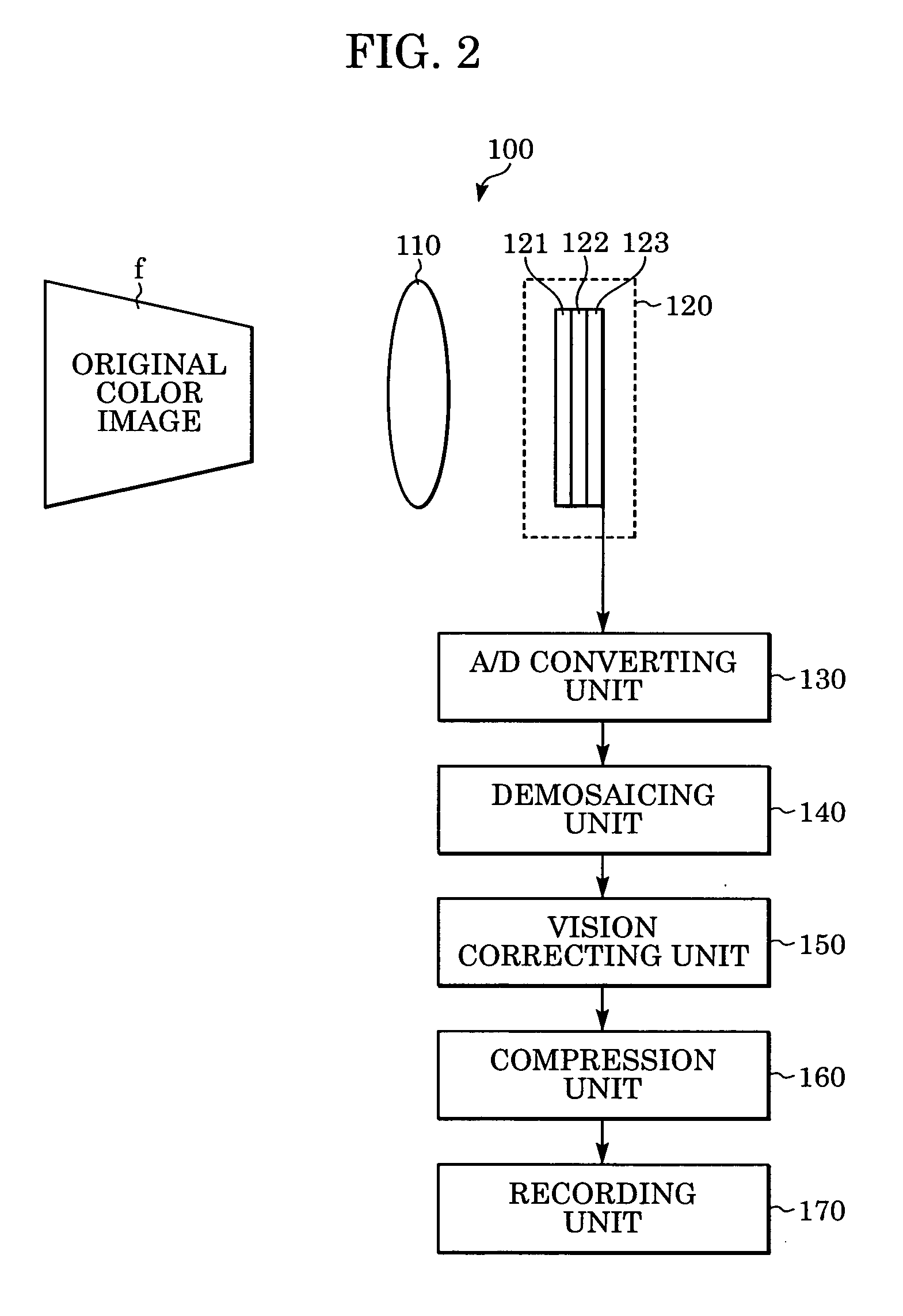Image processing device, image processing method and image processing program
a technology of image processing and image processing method, applied in the field of image processing device, image processing method and image processing program, can solve the problems of spatial resolution degrade, essentially decreasing resolution, and pixel count for a specified color
- Summary
- Abstract
- Description
- Claims
- Application Information
AI Technical Summary
Problems solved by technology
Method used
Image
Examples
first embodiment
[0093] The image processing device and a color imaging device (digital camera) 100 in which the image processing device is loaded according to the first embodiment of the present invention are described next.
[0094] In FIG. 2, the color imaging device 100 includes an imaging optical system 110, a single-CCD color image sensor 120, an A / D (analog-to-digital) converting unit 130, a demosaicing unit 140, a vision correcting unit 150, a compression unit 160, and a recording unit 170. The original color image f illustrated in FIG. 2 hypothetically illustrates the field, and is not a component of the color imaging device 100, but is shown in FIG. 2 for the purpose of explanation.
[0095] The photographed original color image f is formed upon the single-CCD color image sensor 120 via the imaging optical system 110. Here, the single-CCD color image sensor 120 includes a color filter array 122 on the front side of a solid-state image sensor 123, and the image which is imaged upon the solid-st...
second embodiment
[0130] The demosaicing process described in the first embodiment is an appropriate method in the case in which the noise generated in the solid state image sensor 123 and the A / D converting unit 130 is modeled, assumed to follow a Gaussian distribution. This is applicable to the case with noise wherein the dark current of the solid-state image sensor 123 is dominant.
[0131] On the other hand, with the combination of a solid-state image sensor with high sensitivity and low noise and an A / D converting unit, the output of the A / D converting nears the photon count, the quantum Poisson noise becomes the dominant noise. In the present embodiment, an appropriate demosaicing process including noise reduction will be described as to a color imaging device that has a high sensitivity and low noise solid-state image sensor.
[0132] The demosaicing process of the present embodiment performs processing according to the same flowchart as in the first embodiment; however, the operations of the comp...
third embodiment
[0141] As an application differing from the first and second embodiments of the present invention, a color imaging device with a color filter array such as that illustrated in FIG. 4 will be described. The configuration of the color imaging device of the present embodiment is similar to the color imaging device 100 described in the first embodiment, but the color pattern of the color filter array 122 differs from the first embodiment.
[0142] The color filter array 122 of the present embodiment has, other than the normal RGB color filters R, G, B, a G filter DG with low transmission, and is a four-color color filter with R, G, B, and DG. The color response vector in the RGB color space of the pixels corresponding to the various color filters shall be (100)·(010)·(001)·(00.20)(42)
[0143] Further, the solid-state image sensor 123 and the A / D converting unit 130 attain output saturation (luminescence saturation) even if the light is cast into the pixels with an intensity greater than 1,...
PUM
 Login to View More
Login to View More Abstract
Description
Claims
Application Information
 Login to View More
Login to View More - R&D
- Intellectual Property
- Life Sciences
- Materials
- Tech Scout
- Unparalleled Data Quality
- Higher Quality Content
- 60% Fewer Hallucinations
Browse by: Latest US Patents, China's latest patents, Technical Efficacy Thesaurus, Application Domain, Technology Topic, Popular Technical Reports.
© 2025 PatSnap. All rights reserved.Legal|Privacy policy|Modern Slavery Act Transparency Statement|Sitemap|About US| Contact US: help@patsnap.com



